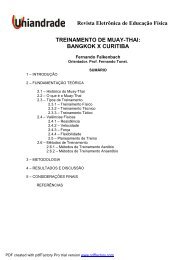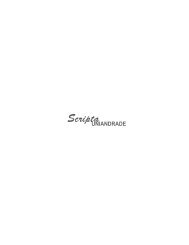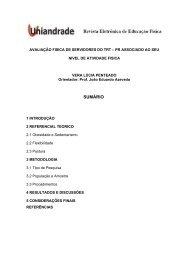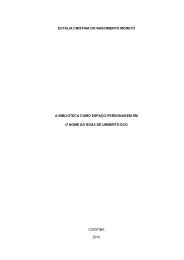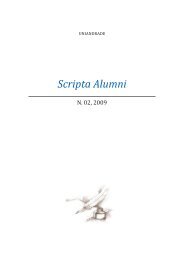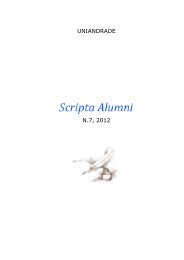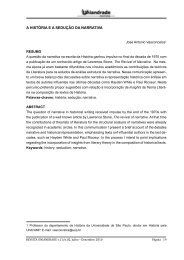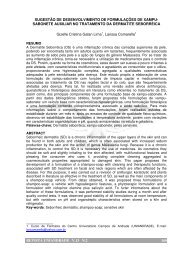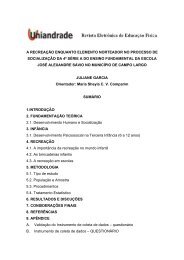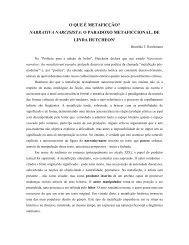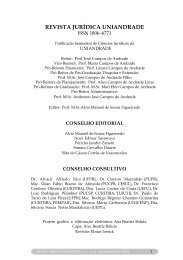Scripta 9_2_link_final.pdf - Uniandrade
Scripta 9_2_link_final.pdf - Uniandrade
Scripta 9_2_link_final.pdf - Uniandrade
Create successful ePaper yourself
Turn your PDF publications into a flip-book with our unique Google optimized e-Paper software.
that his brother is alive in the coffin, Dudu shoots towards it. Also, to the<br />
sound of Prokofiev, the spectator sees then a thread of blood running<br />
through an invisible crack in the coffin.<br />
From there, the camera moves through the unorganized architectural<br />
compound of the shanty town, where we see a waving flag of a popular<br />
soccer team. In voice-over the spectator is told: “The Community of Maré<br />
Radio Station now closes its daily activities”. The image of a solitary rooster,<br />
who will probably announce brighter mornings, is also brought to the screen,<br />
associated to the voice-over.<br />
And so ends this story of another Romeo and another Juliet, or<br />
Lucia Murat‘s Romeo and Juliet. I have not attempted to build a critical study<br />
of the film. I have just argued that intersemiotic translation of canonical<br />
works of art, that is, “performances of mass media which remain excluded<br />
from the universities and museums, ‘uncapable’ of reading and looking at<br />
the high brow cultures because they ignore the history of knowledge and<br />
styles” (CANCLINI, 2008, p. 205) can help in the education of today’s socalled<br />
plain individual. After all, as Silviano Santiago reminds us, in a peripheral<br />
country such as Brazil, it will not be through the painful exercise of a mere<br />
teaching of basic reading and writing skills that the excluded illiterate<br />
individual will assimilate information and use it in the understanding of<br />
society and the world where he/she lives (SANTIAGO, 2004, p.129).<br />
Translation reaches the public through the cinema, television, comic<br />
strips, cartoons, books not as another model, but as a producer of instability<br />
which speaks for itself, is unfaithful, and does not submit itself to the ‘essence’<br />
of an origin. It sets its own logic. And through this very logic it offers a<br />
chance for democratization of the arts, bringing the outside world closer<br />
to the contemporary individual, in a country where a huge mass of culturally<br />
excluded people do not have access to the live performances or to texts<br />
published in a foreign language.<br />
REFERENCES<br />
CANCLINI, Néstor Garcia. Culturas híbridas. Trad. Heloísa Pezza Cintrão; Ana Regina<br />
Lessa. 4ª. ed. São Paulo: EDUNESP, 2008.<br />
<strong>Scripta</strong> <strong>Uniandrade</strong>, v. 9, n. 2, jul.-dez. 2011 125



